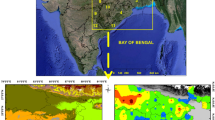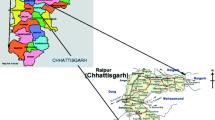Abstract
Three extreme cases of seasonal precipitation over 31 contiguous meteorological subdivisions of India were decomposed into orthogonal components using eigenvector technique to examine their spatial and temporal behaviour. The first two eigenvectors combined were found to represent the seasonal precipitation over India to a sufficient high degree of accuracy retaining 90–95 percent of the total variance. These two components show high spatial similarity in all the three cases of the precipitation examined.
The first component is characterized by a coherent variation over the area with large coherent variation over the north-east India, Central India and the west coast of India. The coefficients of the component show annual behaviour with the peak values generally reached during July. This component is representative of the summer monsoon (June–September) mode.
The second component characterizes out of phase variation in precipitation between Central India, adjoining parts of the area, and peninsular India. The coefficients of the component show the semi-annual oscillation. It appears that the role of the second eigenvector might be to represent regionality of the seasonal march of the monsoon rain.
Similar content being viewed by others
References
Bedi, H. S. andBindra, M. S. (1980),Principal components of monsoon rainfall. Tellus32, 296–298.
Davis, R. E. (1976),Predictability of sea-level pressure anomalies over the North Pacific Ocean. J. Phy. Oceanogr6, 249–266.
Gadgil, S. andIyengar, R. N. (1980),Cluster analysis of rainfall stations of the Indian peninsula. Quart. J. Roy. Met. Soc.106, 873–886.
Gadgil, S. andJoshi, N. V. (1983),Climate cluster of the Indian region. J. Climat.3, 47–63.
Kutzback, J. E. (1967),Empirical eigenvectors of sea-level pressure, surface temperature and precipitation complex over North America. J. Appl. Meteorol.6, 791–802.
Kidson, J. W. (1975),Analysis of monthly mean surface data. Mon. Wea. Rev.103, 177–186.
Lorenz, E. N. (1956),Empirical orthogonal functions and statistical weather prediction. M.I.T. Dept. of Meteorol. Sci. Rept.1.
Prasad, K. D. andSikka, D. R. (1982),A study of the empirical functions of the height fields over India and their relation with the rainfall. Proc. Indian Acad. Sci. (Earth Planet, Sci.)91, 167–187.
Subbaramayya, I. (1968),The inter-relations of monsoon rainfall in different sub-divisions of India. J. Meteor. Soc. Japan46, 77–85.
Sikka, D. R. andPrasad, K. D. (1981),Empirical orthogonal analysis of 700 mb geopotentials during the summer monsoon over Asia. J. Climat.1, 367–379.
Author information
Authors and Affiliations
Rights and permissions
About this article
Cite this article
Prasad, K.D. The spatial and temporal characteristics of the seasonal precipitation over India. PAGEOPH 123, 468–475 (1985). https://doi.org/10.1007/BF00880745
Received:
Revised:
Issue Date:
DOI: https://doi.org/10.1007/BF00880745




